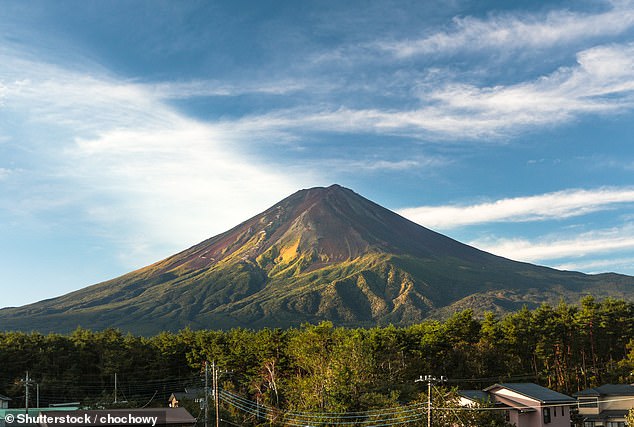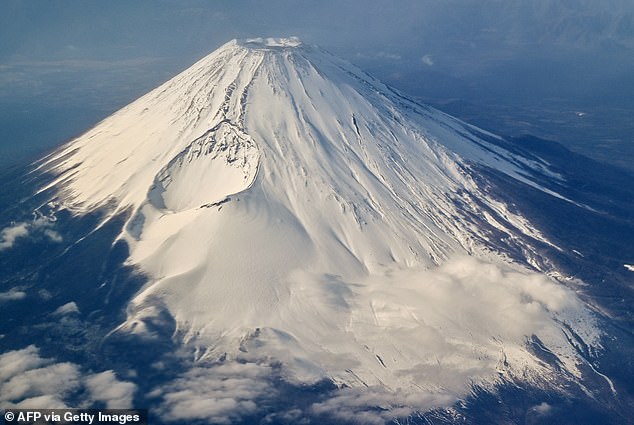Each year, the majestic views of Mount Fuji’s snow-capped peak draw hundreds of thousands of tourists from around the world.
But many visitors will be in for a disappointment this year as Japan’s highest peak is still snowless almost a month later than expected.
As of this Monday, there was no snow on Mt Fuji’s peak – marking the latest date that the mountain has been bare since records began 130 years ago.
This beats the previous record of October 26 which occurred once in 1995 and again in 2016.
According to the Kofu Local Meteorological Office (KLMO), snow typically forms on Mount Fuji by October 2 and settles around October 5.
Experts say the lack of snow is due to an unseasonably hot summer and autumn coupled with high levels of rainfall.
However, they also note that climate change may have had a degree of impact on how late the snow has formed.
Yutaka Katsuta, a forecaster at KLMO, told AFP: ‘Temperatures were high this summer, and these high temperatures continued into September, deterring cold air.’

Mount Fuji is still snowless according to meteorologists, marking the latest date the mountain has been without snow in 130 years

Mount Fuji is located just 62 miles (100km) southwest of the capital Tokyo and is Japan’s largest mountain, standing at 3,776m (12,388ft)
Standing at 3,776m (12,388ft) tall, Mt Fuji is Japan’s tallest mountain and also one of its most recognisable.
During the winter, its snowy peak can sometimes be seen from Tokyo, 62 miles (100km) to the Northwest.
During the climbing season from July to September, as many as 220,000 visitors make the long trek up to the summit.
Each year, meteorologists from the Kofu branch of the Japan Meteorological Agency are tasked with climbing onto the roof of their office to see whether a snowcap has formed on the mountain 25 miles (40km) away.
Due to the frequently cloudy weather, the scientists are only able to make observations once every few days when the weather is cold enough for snow to form.
However, when an observation window finally opened on October 28, they were shocked to find the mountain was still bare.
In a typical year, snow begins to form shortly after the end of the climbing season around the start of November and lasts for most of the year.
However, meteorologists warn that unseasonably warm temperatures have pushed the date of snowfall back to the latest point since records began in 1894.

On average, snow forms on Mount Fuji by October 5 and remains in place for most of the year. However, there is still no snow – more than 20 days later than normal

Previous studies have shown that climate change has been reducing the size of snowpacks on mountains around the world, with Europe and America being most affected
Mount Fuji
Height: 3,776m (12,388ft)
World Height Ranking: 35th tallest
Location: Shizuoka Prefecture, Japan
Mount Fuji is the tallest mountain in Japan and also one of the country’s ‘Three Holy Mountains’.Its name is believed to come from the ancient words for ‘fire’ and ‘mountain’.The mountain is an active volcano and last erupted 300 years ago.It has been the subject of many famous pieces of Japanese art, including The Great Wave off Kanagawa.Each year, 220,000 visitors make the trek to the summit.<!- – ad: https://mads.dailymail.co.uk/v8/us/sciencetech/none/article/other/mpu_factbox.html?id=mpu_factbox_1 – ->
Advertisement
The simple reason is that it has been too warm in Japan for snow to form over the last few months.
This year, Japan experienced its joint hottest summer on record, with unseasonably warm temperatures extending into October.
The average temperature across Japan during the summer was 1.76°C (3.17°F) hotter than usual – smashing a previous record of 1.08°C (1.94°F) set in 2010.
Even in the first week of October, 74 Japanese cities reported temperatures in excess of 30°C (86°F) according to research by Climate Central.
Combined with high levels of rainfall this has made it impossible for snow to form on Mt Fuji at the normal time.
Research suggests that climate change has made extreme temperature events such as this year’s heatwaves significantly more likely.
According to research published by Climate Central, the unusual October heat was made three times more likely by climate change.
Likewise, studies have shown that the warming effects of climate change have been reducing the size of snowpacks all over the world.

Each year more than 200,000 climbers make the long trek up Mount Fuji during the climbing season (pictured). Unseasonably hot temperatures and rain this summer mean that there has been snow falling on the mountain so far

Meteorologists suggest that the El Niño year in 2023-24 caused global temperatures to be hotter than average, which may have contributed to the lack of normal snow formation
The paper, published by Dartmouth College earlier this year, found that most of the world’s snowpacks had shrunk over the last 40 years with some losing 10 to 20 per cent of their size every decade.
Mamoru Matsumoto, a forecaster at KLMO, told The Asahi Shimbun: ‘I believe one of the causes is global warming, but I don’t know what the exact reason is.’
However, this year’s exceptionally late snowfall has also been impacted by naturally occurring climate patterns.
Japan’s warm weather was not a local phenomenon, but was felt all around the world.
Last summer broke the global average heat record for the second year in a row, putting 2024 firmly on course to be the hottest year ever.
During 2023-24 the world experienced an El Niño year, a natural cycle during which weakening Trade Winds allow warm water to drift towards the West coast of the Americas.
This leads to a period of warmer, wetter weather which may have contributed to the lack of snow on Mount Fuji.

AloJapan.com